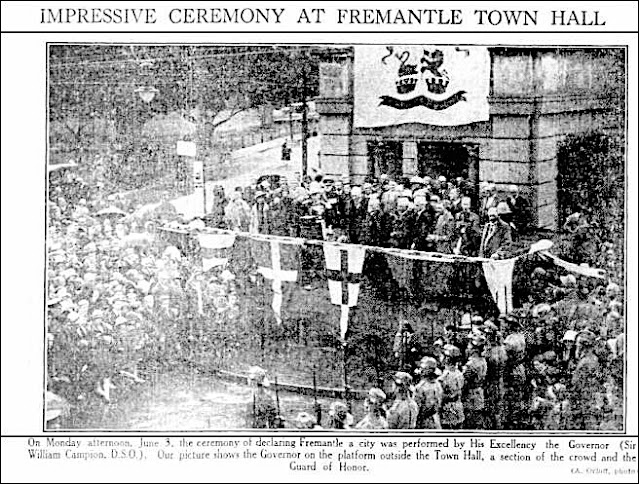Fremantle is located at the mouth of the Swan River, 14.41 km from Perth, Western Australia. It is home to the Whadjuk people, is a port city with
a maritime past, has impressive Victorian architecture and significant history as a British penal colony.
The Whadjuk People
Fremantle (Wal’yulyup) was within the territory of the Whadjuk people, who are part of the Noongar
language group but with their own distinctive dialect. Noongar (Nyungar) is commonly accepted as meaning "person" or "people".
However, Yagan, in 1833, an Aboriginal leader, said that the Noongar word for Fremantle (both sides of the river) Waylyup means "lungs". The Lungs idea appears to derive from the easterly wind which travels
down from the hills and along the river to Fremantle in the morning. Beeliar is the name of the country on which Fremantle is situated.
 |
| Scarring by Aboriginal people was once practised widely, but is now restricted almost entirely to parts of Arnhem Land, Western Mail (Perth, WA : 1885 - 1954), Thursday 31 March 1927 |
In Aboriginal mythology, the Wagyl fought the
Crocodile spirit and used the crocodile’s tail to separate fresh
water from salt water, at the mouth of the Swan River. Other interesting stories told by the Whadjuk people living in coastal areas told of the separation of Rottnest Island (Wadjemup) from the mainland, which occurred between 12,000–8,000 BCE.
The Cockburn coastline and the limestone ridge behind have many Aboriginal places of significance. Robb Jetty was at the site of an Aboriginal
camping ground. Manjaree (Bathers Beach) was a place of trading and ceremonies.
Interestingly, Aboriginal people who lived around Fremantle did not make canoes or other watercraft. Artefacts found on Rottnest and Garden Islands, were from a period before the sea levels rises, following the Ice Age, that transformed hills into islands. A Dreaming story tells of a fight between a crocodile and Waugal (the rainbow Serpent) that broke up the land and created Rottnest, Garden and Carnac Islands.
According to the
prominent early settler in Western Australia, George Fletcher Moore (1842/1884), the Aboriginal people of the Swan River tribes believed that the islands off Fremantle separated from the mainland in the following way:
“the natives have a tradition that rottnest, carnac and Garden Islands once formed part of the mainland and that the intervening ground was thickly covered with trees; which took fire in some unaccountable way and burned with such intensity that the ground split asunder with great noise and the sea rushed in between, cutting off these islands from the mainland.”
Daisy Bates, who worked among Aboriginal people described Wal’yulyup, "the point near Fremantle old jetty" which together with ‘Manjarip, the old Fremantle tunnel [near Arthur’s head] …were old camping places. Bates also
spoke of the spiritual beliefs of the Aboriginal people of the region: “The Aborigines along the whole line of the Western coast believe that when the body dies, the spirit goes away westward through the sea to some country far away, and that there the spirit lives in much the same manner as it has lived when in the flesh...."
The totemic Dingo Ancestor, of the Aboriginal people of the area, is known as dwerda (or doorda).
 |
| Kalgoorlie Western Argus (WA : 1896 - 1916), Tuesday 15 October 1901 |
Many Aboriginal people believed the white men were the returning spirits of their own dead relatives. Another type of ghost was the
jinagabi, which had emu feathers on his feet. Aboriginal people may call on the jinagabi, if seeking "payback". A person cannot escape from the jinagabi.
When the British arrived in the region, the Noongar leader was a man called Midgegooroo, who had had at least two wives. He had at least four sons, Yagan, Narral, Billy and Willim.
In the Noongar language, “moort” means family or relations (kinship system). Each Nyungar person or family identifies with one or more totem(s) and this determines who a person could marry. For example. a man of the Dingo totem could not marry someone from the same totemic group.
The Noongar
divided the year into six distinct seasons. One season, called Birak (December/January), which is dry and hot, was the period in which the Noongar burned sections of scrubland to force animals into the open for easier hunting.
Chert stone artefacts and rock engravings have been found in Cockburn and evidence of campsites around the lakes, have been found.
 |
| A replica in the Brno museum Anthropos. Namaroto spirits and the Rainbow Serpent Burlung (Borlung). |
1829: Fear of The French
The British fear that the French would establish a colony in Western Australia led to Captain Charles Fremantle anchoring his ship,
HMS Challenger, off Garden Island on 25 April 1829. Captain Fremantle officially claimed the western part of Australia for Britain on 2 May, by hoisting the Union Jack, in the name of King George 1V.
Fears that the French were
planning to colonise the Pacific led to garrisons
being established at several places in the north and south of Australia.
Lieutenant Governor James Stirling, the appointed administrator, arrived in Cockburn Sound on 31 May aboard the
Parmelia with his family and other settlers (mainly retired servicemen), to establish a colony at the Swan River in Western Australia. The 69 settlers
encountered a challenging and sandy landscape of "constant heavy winds". On 8 June a military detachment of 56 officers and men also arrived from consort ship
Sulphur.
Lieutenant Governor Stirling in his
proclamation of the colony in June 1829 warned that Aboriginal people were protected by British laws. Any colonist convicted of "behaving in a fraudulent, cruel or felonious manner towards the Aborigines of the Country" would be dealt with "as if the same had been committed against any other of His Majesty's subjects".
 |
| Admiral Sir Charles Howe Fremantle |
The colony's administrator, Lieutenant-Governor James Stirling, arrived on board the barque
Parmelia, on February 1829, with his family and around 69 settlers, marking the beginning of Western Australia as a British Colony.
Bare and Cheerless: First known as “The Swan River Colony"
Lieutenant Breton, R.N., passed through Fremantle on his way to New South Wales in October, 1829.
“Fremantle at the time of my arrival,” he wrote, “was a mere encampment, every person being either in a tent or temporary hut: its site is a level spot, consisting entirely of sand, and the ‘bush,’ or forest, extends to within a very short distance of it. Water was easily procured by digging holes a few feet in depth but it was not particularly good. . . . The only spring near the place was a mile distant, and it fell into the river only a few yards from its source. ... If the site alone be considered, a worse spot for a town could hardly have been selected. Situated as it is upon a bed of sand and exposed to a glare that is almost unsupportable, it holds out but little inducement for any person to fix his residence there, unless compelled by circumstances."
Dr T. B. Wilson, R.N. also
arrived at Fremantle in October 1829. Describing the encampment at the river mouth as “several tents pitched in a low sandy neck of land”.
Fremantle’s first Pilot, Daniel Scott, operated his own boat from Arthur Head in 1829.
 |
| Captain Dan Scott, West Australian (Perth, WA : 1879 - 1954), Friday 31 May 1929 |
1830s
In 1832 more people left the Swan River Colony than arrived. The town consisted of a few wooden huts and ragged tents. The barren and triangular peninsula on which the town stood was bisected by a long street running as far as Arthur's Head, where it was buttressed by the one outstanding building of the settlement—a peculiar, stone-built prison. (Western Mail (Perth, WA : 1885 - 1954), Thursday 27 October 1949)
 |
| Inside the Roundhouse, the old gaol at Fremantle, WA, Around the walled enclosure are the cells and offices, in the centre of the yard is the coping of the well, Western Mail (Perth, WA : 1885 - 1954), Thursday 27 October 1949 |
Some settlers described the settlement in less than complimentary terms: a "bare, barren-looking district" populated with "cheerless dissatisfied people with gloomy looks, who plod through sand, from hut to drink grog and grumble out their discontent to each other".
However, Captain Fremantle was more enthusiastic when he visited three years later. He saw the promise of the settlement growing into a large town.
Captain Irwin arrived in Fremantle as Captain in command of 68 men of the 63rd Regiment. Many of his troops had fought in the Napoleonic Wars.
In Irwin's book, published in London in July 1835, he described Fremantle from the perspective of approaching the settlement by sea:
“The site of the town is indicated by a handsome octagonal building of white cut stone, erected near the edge of a precipice which overhangs the mouth of the river. On landing, the stranger has the pleasure of entering a small but neat town, with wide streets, some of which have been macadamized. The streets are laid out at right angles with each other and the houses are constructed either of white stone or of wood that is painted over. . . . Fremantle contains several hotels, where travellers may partake of excellent accommodation and a good table. The principal one is equal in appearance and comfort to a good English country inn".
 |
| A photograph of The Round House in the late 19th century, PD |
Preston Point Jetty
In 1830, John Weavell made a jetty at Preston Point and operated a cross-river ferry to Rocky Bay. In 1833, he said that about 80
Aboriginal people were fishing and camping in this area and a few years later, Yagan was also sighted here.
 |
| British Library digitised image from page 169 of "Western Australia in 1891. By Francis Hart [With maps and plates.]" "Western Australia in 1891. By Francis Hart British Library |
In April 1833, a report spread that a "landing of 200 natives" had speared the ferryman, John Weavell, and his wife
at their home near Preston Point, which "brought nearly every male inhabitant of Fremantle to my house, some with guns without locks, some with guns without ammunition, others with ammunition without guns, some with pistols, others with bludgeons".
It was later
reported in the Perth Gazette that this report of events was entirely false and an example of the "extravagant and absurd statements that are daily got up".
Preston Point, April 12th, 1833
To the Editor of the Perth Gazette,Sir,
I beg leave to avail myself of the opportunity, which your columns will, I trust, afford me of returning my sincere thanks to the inhabitants generally of Fremantle, as also to those gentlemen (from residents, but who happened to be there) for the very kind feeling evinced by their prompt aid and assistance this day on hearing the report of my premises having been destroyed, and Mrs. Weavell speared by the natives.—I regret exceedingly, a report so groundless should have been spread, thereby occasioning so much trouble, and probably inconvenience to many who instantanously left their homes and business, to render every assistance in their power, and shall at all times think of the circumstance with gratified rememberance.I am Sir,
Yous "Respectfully
JOHN WEAVELL.
Midgegooroo
Midgegooroo, a Nyoongar man, was involved in many confrontations with settlers. He was caught and executed outside Perth gaol in May 1833. The event that played a large part in his execution appears to be an act of retaliation for the killing of an Aboriginal man who stole potatoes and a fowl from the farm of Archibald Butler near Point Walter.
Midgegooroo and Yagan attacked Butler's homestead and killed a servant Erin Entwhistle, whose son Ralph, then aged about ten, gave a deposition identifying Midgegooroo as the principal offender:
"They thrust spears through the wattle wall of the house – my father was ill at the time – he went out and was instantly speared. I saw the tall native called Yagan throw the first spear – which entered my father's breast, and another native Midgegooroo threw the second spear, which brought my father to the ground. I am quite sure the native now in Perth jail is the very same who threw the second spear at my father – I know him by the remarkable Bump on his forehead.........."
Captain Iwin, however, had been unsure what to do with Midgegooroo:
"there is a great puzzle to know what to do with him. The populace cry loudly for his blood, but it is a hard thing to shoot him in cold blood. There is a strong intention of sending him into perpetual banishment in some out of the way place." Irwin went on to say: "He was over 50 and so he was too old to offer any chance of amendment, so I reluctantly ordered him to be executed. He was shot on May 22, 1833."
Midgegooroo reported to be an older man, short in stature with long hair and a "remarkable bump" on his forehead, left at least two wives.
Lieutenant Bunbury, a soldier and explorer who spent four years in the southern hemisphere colonies between 1834 and 1837, described Fremantle. early in 1836:
"At the entrance to the Swan is the town of Fremantle, where there are some good houses, which were built in the first days of the colony, but are now rapidly going into decay; many of them are half buried in the loose white sand, which drifts with every breeze and smothers the fences and even walls of the town."
The Bank of Western Australia was
established in 1837.
 |
| Sketch of the town of Fremantle from the Court House - Arthur's Head, Western Australia [picture] / C.D. Wittenoom, 1839, SLWA |
However, by 1842, the town of Fremantle was well laid out, having two hotels, Government buildings and three or four stores.
The Parkhurst boys were juveniles from a reformatory attached to Parkhurst Prison on the Isle of Wight. They were sentenced to "
transportation beyond the seas" and sent to Australia and New Zealand between 1842 and 1852.
The Simon Taylor arrived in Fremantle in August 1842, and a notice in the Government Gazette dated 23rd September 1842 called for "Applicants for the services of any of these boys must be made to John Schoals Esq., Guardian under the Act".
By the end of 1842, nine boys were in a trade, six were farm lads, and three were servants.
The population of Fremantle in 1843 was at 387.
The first steamship to enter the port was
HMS Driver on 4 December 1845. She is credited with the first global circumnavigation by a steamship when she arrived back in England on 14 May 1847.
 |
| HMS Driver was a Driver-class wooden paddle sloop of the Royal Navy. She is credited with the first global circumnavigation by a steamship when she arrived back in England on 14 May 1847 |
1850sThe barque, the Scindian, delivered the first convicts to Fremantle on 1st June 1850. The 75 male convicts from Portsmouth were initially housed in the warehouse premises of the harbourmaster, which is now the site of the Esplanade Hotel. However, soon enough, work began on the Convict Establishment prison, now Fremantle Prison.
The Fremantle Mechanics Institute was established on August 8th 1851.
In the early 1850s, a police force was established, and the Warden’s Cottages built. A court house was built upon Arthur’s Head, and a small house for the lighthouse keeper erected. Three bonded Warehouses in Fremantle were nearly completed.
 |
| Henry Wray's residence aka Government House, was constructed after 1850 as the residence of Royal Engineer Lieutenant-General Henry Wray. The building was demolished in 1939 and Fremantle Hospital is now on the site. Truth (Perth, WA : 1903 - 1931), Sunday 23 February 1930 |
Mannings Folly, located on the corner of Pakenham Street and Short Street, was erected in 1858, as a private home for Charles A. Manning in Fremantle. The building was demolished in 1928.
The economy was being built around wheat, meat and wool.
In 1859, the population was 2,946.
 |
Buildings of old Fremantle, (1) Sole relic of the first bridge across the Swan : The archway under the foot bridge at Fremantle.(2) Built by convicts in 1855 : The gates of Fremantle Gaol.(3) The old fire station.(4) An old prison hut near the traffic bridge. Its convict builder enlarged the chimney sufficiently to crawl through and used to roam the country sideafter locking up time.(5) Low tide beside the traffic bridge reveals the old roadway and landing where convicts used to drag passengers and vehicles across the river in a large punt before the bridge was built. The old traffic bridge depicted elsewhere. (6) Built by convicts in the middle of last century : The Round House at Arthur's Head.(7) Inside the Round House. Sheltered by the wooden structure in the corner, a warder used to keep watch on the prisoners.
(8) Near the Old Women's Home, this building, constructed by convicts, was the first asylum in Western Australia.(9) The old Governor's Residence, wholly built by convict labour. Western Mail (Perth, WA : 1885 - 1954) |
1860s: Royal Visit
 |
| The original St John's Church, Fremantle, WA, as it was in 1863, in the middle of Kings Square before the current St John's Anglican Church was built and opened in 1882, SLWA |
 |
| Arthur's Head 1860s, Fremantle, WA, Western Mail (Perth, WA : 1885 - 1954), |
 |
| A regatta is held at Fremantle Bridge, WA, ca. 1865, SLWA |
The first royal visit to Western Australia was in 1869, by Queen Victoria’s second son, Prince Alfred, Duke of Edinburgh, in
HMS Galatea.
 |
| Three masted sailing ship H.M.S. Galatea, ca. 1868 Alfred, the Duke of Edinburgh was a naval officer and the H.M.S. Galatea was his first command. The Galatea was in Australian waters from October 1867 till June 1868 while the Duke completed the first royal tour of Australia |
The Fenians Escape!
In 1867, 62 men belonging to the Fenians who wanted a Free and Independent Ireland were sent to Fremantle. One of these convicts, John Boyle O'Reilly, escaped in 1869 with the help of an Irish priest. He was picked up by the American whaler, the Gazell and transported to the United States.
By 1871, all convicted Fenians had been pardoned, except a group from Fremantle prison. One of these Fenians posted a letter to the US, and it came to the attention of John Devoy ( Irish rebel leader and exile) and John Boyle O'Reilly. A plan was hatched that took 4 years to bring about and the money of Irish people from around the world.
First, the whaler Catalpa was purchased, and in 1875, under the command of Captain George Anthony, it sailed for Fremantle. On 17 April, the Catalpa dispatched a whaleboat to shore at Fremantle, and the six Fenians, working in work parties outside the prison walls, Thomas Darragh, Martin Hogan, Michael Harrington, Thomas Hassett, Robert Cranston and James Wilson, all successfully absconded and made it to America.
 |
| John Boyle O'Reilly |
Convict Transportation Ends
The first Fremantle bridge was built out of timber by convict labour from 1863-7.
Convict transportation ended in 1868 with the arrival of the
Hougoumont. This last convict ship delivered 281 convicts (67 Irish political prisoners) to Fremantle from Britain. Almost 10,000 male convicts had arrived at the Swan River penal colony over 18 years; labour provided by the convicts significantly
contributed to the development of the colony.
1870s
By 1870, the population of Fremantle was close to 4000.
1871 Town Council created.
Fremantle Long Jetty was constructed in 1873 to replace the smaller South Jetty.
 |
| Panorama of Fremantle from Gaol Hill, 1870, SLWA |
Fremantle became a municipality in 1883.
 |
| Fremantle Jetty and Bathers' Beach, WA, 1870, SLWA |
 |
Inquirer and Commercial News (Perth, WA : 1855 - 1901), Wednesday 30 August 1871
|
A Famed Photographer
Alfred Chopin (1846 –1902) was transported to the colonies, arriving at Fremantle, in 1867, for receiving stolen goods. Though in February 1869, he received a free pardon, having been falsely accused.
The governor then commissioned Chopin to take some photographs "As a token of official remorse" for his wrongful conviction and imprisonment, which allowed Chopin to add "by appointment to His Excellency" on his advertisements. Chopin
achieved considerable fame as a photographer.
 |
| Western Australian Times (Perth, WA : 1874 - 1879), Tuesday 29 August 1876 |
 |
| Victorian Express (Geraldton, WA : 1878 - 1894), Wednesday 2 July 1879 |
|
This original photograph taken by Alfred Chopin, is the only known photograph of Joseph Bolitho Johns (1830-1900), better known as the Western Australian bushranger, Moondyne Joe.
 |
| Moondyne Joe aka Joseph Bolitho Johns |
 |
| Herald (Fremantle, WA : 1867 - 1886), Saturday 22 May 1880 |
In 1881 the railway from Fremantle to Guildford was officially opened.
 |
| This old photo, taken at the yards of Mews and Co. at The Tunnel, Fremantle, during the 1880s, (WA), Sunday Times (Perth, WA : 1902 - 1954) |
1890s: W.A. Gold Rush |
Fremantle, WA, elevated view west along High Street, circa 1890. WA State Library
|
In the 1890s, the gold rush boosted the population and economy of Fremantle when thousands of hopeful prospectors, and camels with their drivers, passed through the town on their way to
Kalgoorlie and
Coolgardie. People flocked to the goldfields from within Australia and other parts of the world.
With so many ships arriving in the harbour at this time, it was decided in 1897 to blast the mouth of the Swan River, so that even larger ships could gain access to the waterways. This port development
increased the growth and prosperity of Fremantle even further so that by the early 1900s, Fremantle's population was close to 15,000.
 |
| View of Fremantle Jetty, circa 1891, British Library digitised image from page 109 of "Western Australia in 1891. By Francis Hart |
 |
| A view of Fremantle Harbour, WA, "Western Australia in 1891. By Francis Hart, British Library |
_p103_THE_HARBOUR_OF_FREMANTLE%2C_WESTERN_AUSTRALIA.jpg) |
| The harbour of Freemantle, WA, circa 1891 |
_p109_FREMANTLE_JETTY.jpg) |
| Fremantle Jetty, WA, circa 1892 |
 |
| The Esplanade Hotel, Fremantle, WA, was designed by J H Eales and built in 1897, Weekly Times (Melbourne, Vic. : 1869 - 1954), Saturday 10 September 1898 |
 |
| The Cleopatra Hotel , Fremantle WA, Weekly Times (Melbourne, Vic. : 1869 - 1954), Saturday 10 September 1898 |
 |
| Plympton Hotel, EAST FREMANTLE WA, Weekly Times (Melbourne, Vic. : 1869 - 1954), Saturday 10 September 1898 |
 |
| Entrance, view from south-west, 1899, Fremantle Prison, WA |
Prosperity
The Western Australia gold rush of the 1890s led to a population and prosperity boom in Fremantle, as the port was a gateway into the region.
1900s
 |
| Port Brewery Fremantle, WA, W.A. Record (Perth, WA : 1888 - 1922), Saturday 15 December 1900 |
 |
2nd W.A. Contingent to the Boer War marching through Fremantle, 2 February 1900. State Library of WA
|
 |
| South Terrace, Fremantle, W.A. - very early 1900s, Aussie~mobs |
 |
| Fremantle Municipal Tramways tram no 1, outside the High Street car barn, at the opening of the Fremantle tramway network, circa 1905, WA |
 |
| Tramlines being laid in Fremantle, Western Australia, in 1905 |
 |
| Swan River Bridge in Fremantle, W.A. - circa 1905, Aussie~mobs |
 |
| South Beach, Fremantle, W.A. - very early 1900s Aussie~mobs |
 |
| Old convict built bridge, Fremantle, WA, Western Mail (Perth, WA : 1885 - 1954), Saturday 19 October 1907 |
 |
| Market Street, Fremantle, W.A. - very early 1900s, Aussie~mobs |
 |
| Kalgoorlie Western Argus (WA : 1896 - 1916), Tuesday 20 November 1906 |
Outbreak of bubonic plague in Fremantle in 1906 led to various buildings in the town being demolished.
Underground telephone cables were laid between Fremantle and Cottesloe, WA, in 1906.
 |
| Underground telephone cables were laid between Fremantle and Cottesloe, WA, in 1906.Western Mail (Perth, WA : 1885 - 1954), Saturday 23 June 1906 |
 |
Railway yards, Fremantle, 1906-1907. State Library of WA
|
 |
| Sunday Times (Perth, WA : 1902 - 1954), Sunday 6 October 1907 |
 |
| Market Street, Fremantle, W.A. - very early 1900s, Aussie~mobs |
 |
| Fremantle Harbour, Western Australia, circa 1908, Fremantle Harbour, Western Australia, Cultural Collections |
1909: The Only Woman To Be Hanged in Western Australia
Martha Rendell (1871 –1909) is buried at Fremantle Cemetery, in the same grave where the notorious serial killer, Eric Edgar Cooke was interred over half a century later. Rendell was convicted of murdering her de-facto husband's son, Arthur Morris, in 1908 and also suspected of killing his two daughters, Annie and Olive, by coating their throats with hydrochloric acid and claiming that it was medicine.
Another child, George Morris, was located and he claimed that he ran away, because his stepmother had killed his siblings and was trying to poison him with spirits of salts (i.e. hydrochloric acid). The public expressed significant outrage during Rendall's trial and she was referred to as a "scarlet woman" and "wicked stepmother". This led police to exhume the bodies of the three deceased children and indeed, diluted hydrochloric acid was found on their throats.
Rendell protested and claimed her innocence, but she was executed by hanging on the 6th of October 1909.
 |
Martha Rendell (10 August 1871 – 6 October 1909)
|
 |
Goulburn Evening Penny Post (NSW : 1881 - 1940), Thursday 7 October 1909
|
 |
| 1. The radiating exercise yards at Fremantle prison. 2. The bookmakers workshop. Western Mail (Perth, WA : 1885 - 1954), Saturday 14 August 1909 |
WWI
 |
| Australian Imperial Forces: Wounded soldier in High Street, Fremantle, Western Australia - WW1, Aussie~mobs |
 |
| Victoria Quay, Fremantle, W.A., circa 1915, Aussie~mobs |
 |
| RETURNED DARDANELLES HEROES : THE RECEPTION AT FREMANTLE. WA THE HOSPITAL SHIP IN WHICH THE SOLDIERS RETURNED. Western Mail (Perth, WA : 1885 - 1954), Friday 10 September 1915 |
 |
| REINFORCEMENTS LEAVING FREMANTLE TO SHARE IN THE DEFENCE OF THE EMPIRE. E. L. Mitchell. Western Mail (Perth, WA : 1885 - 1954), Friday 10 September 1915 |
 |
| The Witch Soap Factory, North Fremantle.Western Mail (Perth, WA : 1885 - 1954), Friday 14 January 1916 |
 |
| Arrival of 'Königin Luise' in Fremantle, W.A. - 3 August 1919. There were two German ships called Königin Luise. The one in the photo was an ocean liner and later a troopship, before it returned to work as a passenger liner. Aussie~mobs |
1920s
 |
| Fremantle, Western Australia, circa 1920, Museums Victoria |
 |
| Scenes in Fremantle, WA, on the occasion of the visit if the prince, Western Mail (Perth, WA : 1885 - 1954), Thursday 8 July 1920 |
 |
| Government House group, Fremantle, NSW, Western Mail (Perth, WA : 1885 - 1954), Thursday 8 July 1920 |
 |
| Fremantle Bridge Collapse, 22 July 1926, After the floods of 1926. A train had just passed over, then the bridge collapsed. Donna Barber |
 |
Arrival of the HMS Jervis Bay at Fremantle, WA, showing men, women and children on the ship deck, Museums Victoria Collections, circa 1928 |
 |
| Fremantle, WA, Sunday Times (Perth, WA : 1902 - 1954), Sunday 29 January 1928 |
 |
MRS. MINNIE DREWETT She claims to have enlisted at Fremantle in 1915 in the A.I.F., to have
gone as cook on a troopship, and erved in France, where she was wounded. Not till then was her ; sexdiscovered. Daily News (Perth, WA : 1882 - 1955), Wednesday 1 May 1929 |
On 3 June 1929 Fremantle was proclaimed a city.
1930s
 |
| THE POLICE BLACK TRACKER, snapped Jnst as he found where the body of the murdered boy was dropped over the high fence of the Richmond Hotel, Fremantle, WA. A man's footmarks were evident at the spot, and apparently it was from here he picked up the lad's body and carried it to the car where it was found. Mirror (Perth, WA : 1921 - 1956), Saturday 7 April 1934 |
 |
| Japanese naval training squadron which berthed atFremantle, WA.Daily News (Perth, WA : 1882 - 1950), Saturday 13 April 1935 |
 |
| First and Last Store in Australia - Fremantle, W.A. - 1937. Positioned on the wharf at Fremantle, this shop would be the first store seen by travellers arriving on ships from Europe and the last store seen by travellers departing Australian shores. Aussie~mobs |
 |
| Mirror (Perth, WA : 1921 - 1956), Saturday 3 August 1935 |
 |
"KING WINJAN: Chief of the South-West Aborigines (or the "ups," i.e., all those places
ending in "up"). From a photo taken in 1868. Western Mail (Perth, WA : 1885 - 1954), Thursday 28 June 1934 |
During the Second World War, Fremantle was home to the largest base for Allied submarines in the Southern Hemisphere when a US submarine base was established. The first United States submarines arrived in 1942. However, because of the secrecy surrounding this submarine base, few people knew of its existence and how it played an important part in the war effort.
 |
Fremantle Man Reported missing, WX386 Private Albert ("Mick") Reynolds is the onlyson of Mr. andMrs. A. Reynolds of 76 Hubble Street, East Fremantle. He enlisted in September, 1939,Daily News (Perth, WA : 1882 - 1955), Thursday 26 June 1941 |
 |
| USS Phoenix (CL-46) leaving Fremantle, WA, in 1942 - Public Domain Media Search Engine Public Domain Image |
 |
| Western Mail (Perth, WA : 1885 - 1954), Thursday 6 September 1945 |
 |
A rare aerial photo of Fremantle Harbour during WW2 shows nearly 40 ships and submarines around sides of the harbour, WA
|
 |
| Western Mail (Perth, WA : 1885 - 1954), Thursday 22 March 1945 |
Construction of South Fremantle Power Station commenced in 1946.
 |
| West Australian (Perth, WA : 1879 - 1954), Thursday 26 September 1946 |
 |
The Mt Margaret Minstrels at Fremantle before their South-West tour. 1946.
BA1340/ERA4/57A: L-R Back: Rod Schenk, Lindsay Lovick, Joy Earle, May Miller, Esther Schenk, ?, Tom (Turrajie) Graham, Fred Carey; Front: Malcolm McDonald, Dan Harris, Jessie Jones, Laurel Johnston, Lorraine Atkinson, Lois Thomas, Ben Mason, Sadie Corner, State Library of Western Australia |
 |
| Western Mail (Perth, WA : 1885 - 1954), Thursday 19 July 1945 |
 |
CHINESE NURSES. A.I.F. SCHOLARSHIP FUND. Arrival at Fremantle.Charming, highly-trained Chiese women, Misses Alice Cheah and Im Ooi Soh, are the first of a groupof nurses to come to Australia to further their training under the Eighth Divisional Malayan Nursing Scholarship. West Australian (Perth, WA : 1879 - 1954), Wednesday 26 February 1947 |
Cold-Blooded
 |
| Sunday Times (Perth, WA : 1902 - 1954), Sunday 23 July 1950 |
 |
| Royston Rennie, who committed a murder in 1926 and was hanged at Fremantle gaol , Sunday Times (Perth, WA : 1902 - 1954), Sunday 23 July 1950 |
 |
| West Australian (Perth, WA : 1879 - 1954), Monday 18 May 1953 |
 |
| Fremantle shanty town, WA, Sunday Times (Perth, WA : 1902 - 1954), Sunday 29 March 1953 |
1970s
 |
Prisoners in front of Main Cell Block, circa 1971, Fremantle Prison, WA
|
1980s
 |
| Michelle Porteous joined the WA Police Force in 1980 and went on to achieve a number of firsts for women – including first female police court prosecutor and first female appointed to the internal investigations unit. Michelle and her brother Chris were also the first siblings to be rostered on shift together when they were on patrol at Fremantle Police Station in 1981. Grahame |
2002 |
| An unidentified marine technician from HMAS Darwin kisses his girlfriend at a homecoming ceremony for HMAS ANZAC and HMAS Darwin at Victoria Quay, Fremantle, WA. HMAS Darwin left Australia for the Persian Gulf on 28 October 2002, Australian War Memorial collection |
Today Fremantle boasts some of Australia's most outstanding mid-Victorian and Edwardian architecture and a significant maritime history.
Around Fremantle
 |
| Pearce Building, High Street, Fremantle, Western Australia |
 |
| High Street, Fremantle, WA |
 |
| Orient Hotel (Fremantle WA) The Orient Hotel is on the corner of High and Henry Streets in Fremantle, and was designed by Michael Cavanagh. Built by Atkin and Law in 1902/03 |
 |
| Esplanade Hotel, circa 1875. This building stands on the site of the first building used for housing convicts transported from Great Britain in 1850. Fremantle WA |
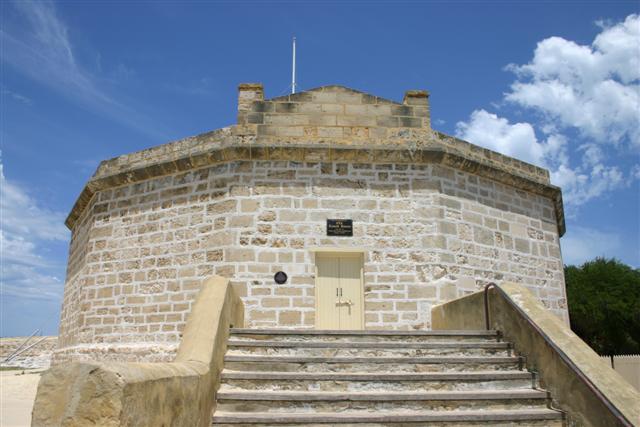 |
| The Round House is the oldest public building in Western Australia, circa 1831 |
 |
Fremantle Town Hall WA, built circa 1887
|
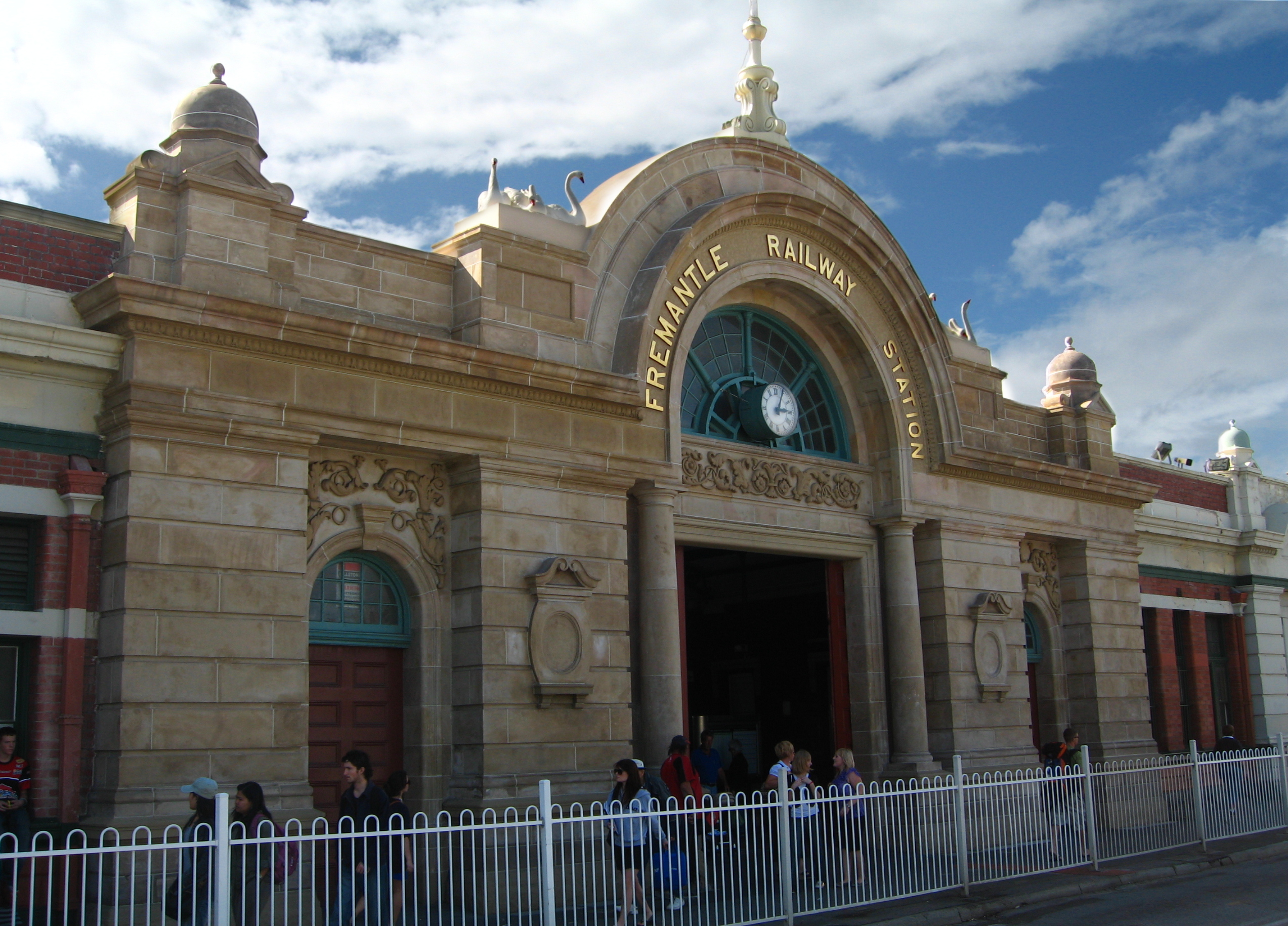 |
| Fremantle Railway Station, WA, circa 1881 |
 |
| The former Courthouse, WA, constructed of Fremantle limestone in 1899 |
 |
| Fremantle Prison, WA, was initially used for convicts transported from Britain. opened 1855 |
 |
| Fremantle Arts Centre, WA, was used as a psychiatric hospital, using convict labour between 1861 and 1868 |
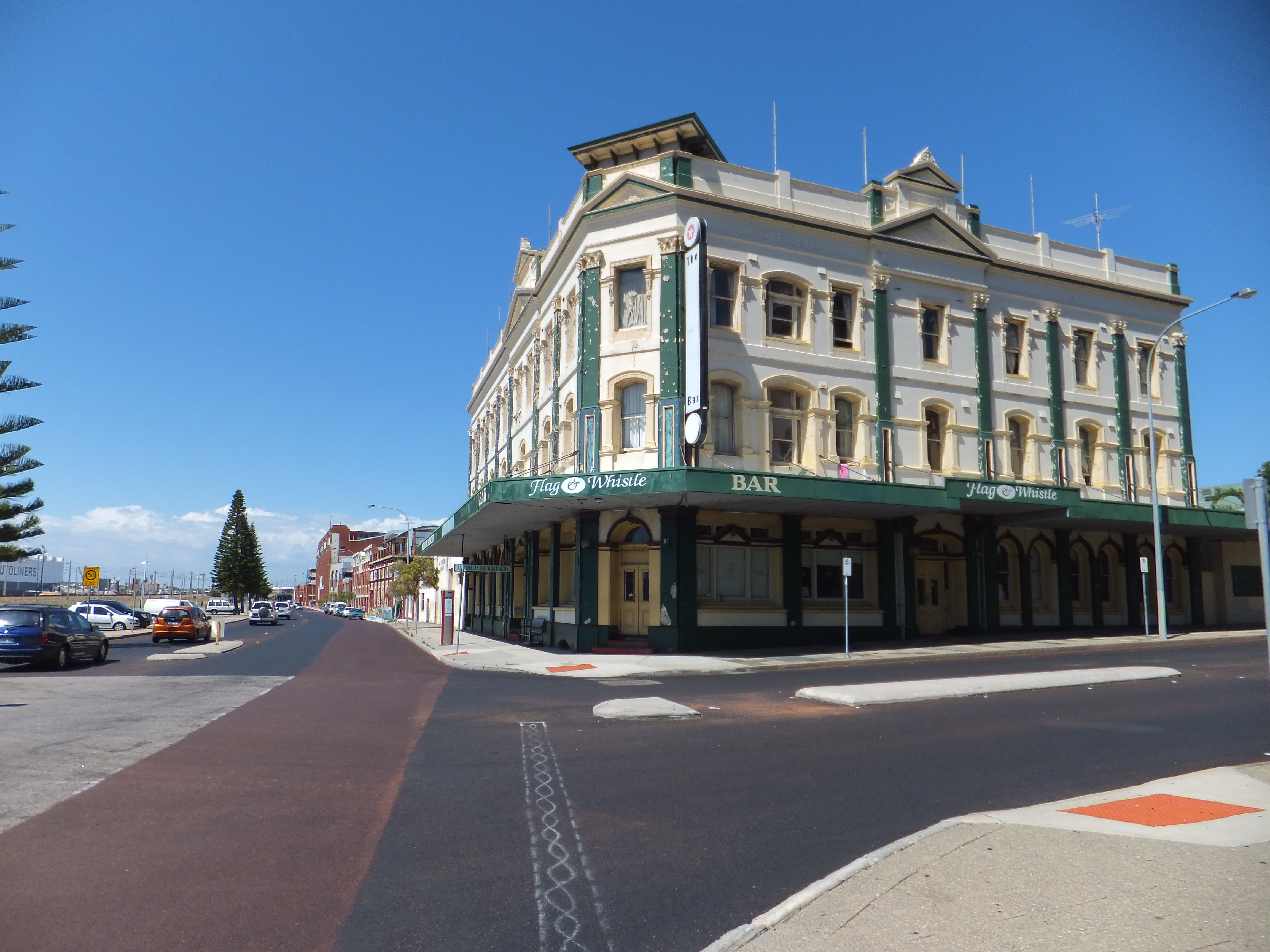 |
| Australia Hotel, Fremantle, WA |
 |
| P&O Hotel, Fremantle, WA, circa 1901 |
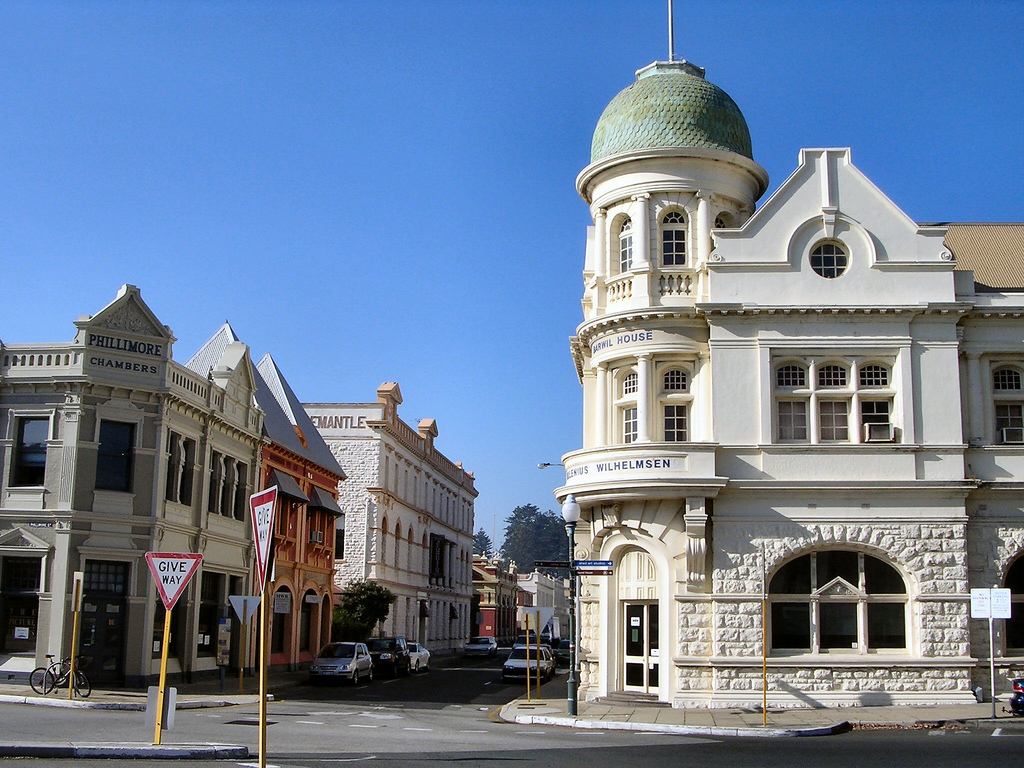 |
| Buildings in the west end of Fremantle, WA |
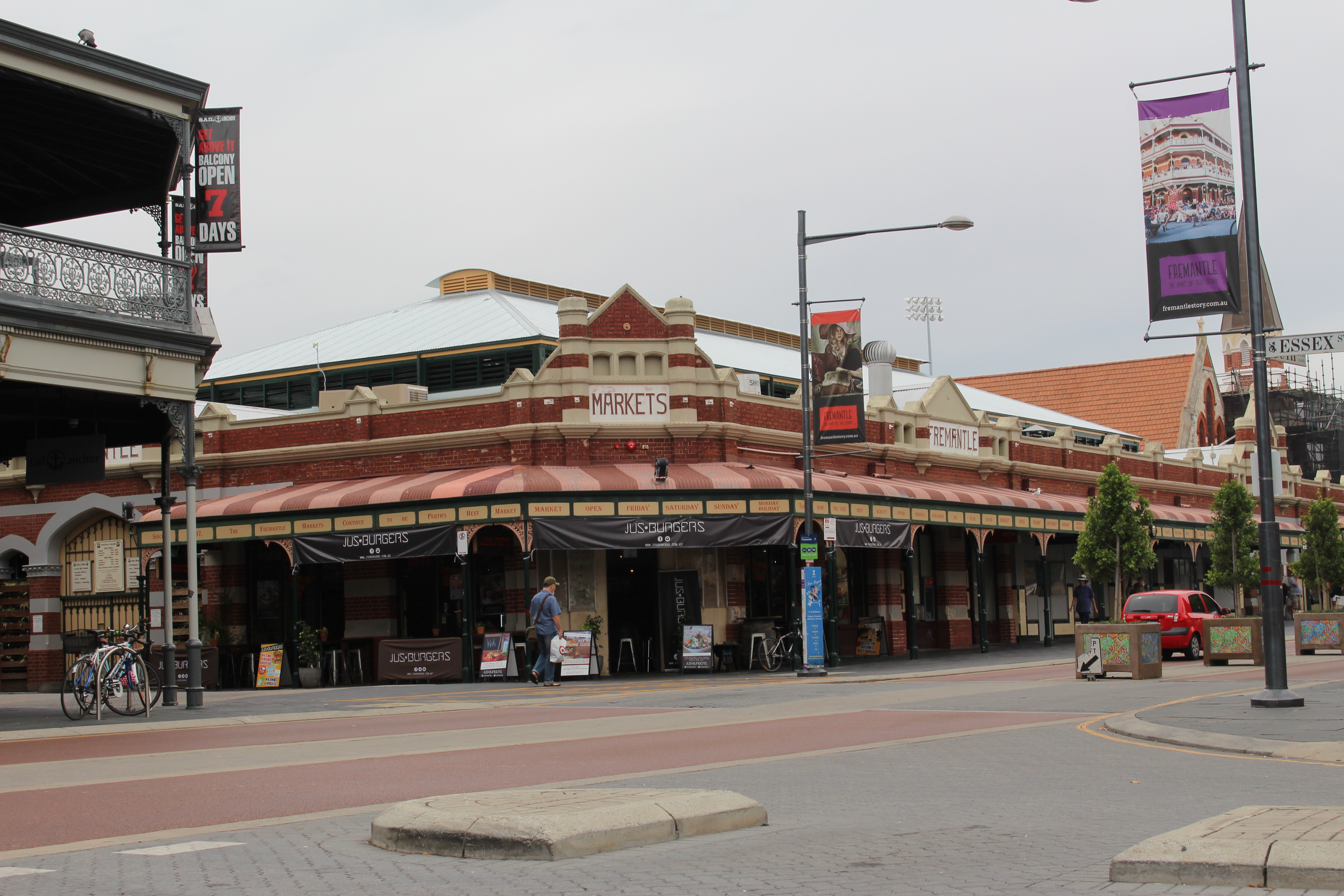 |
| Fremantle Markets, WA, circa 1897 |
 |
| Wesley Church, Fremantle, WA,circa 1899 |
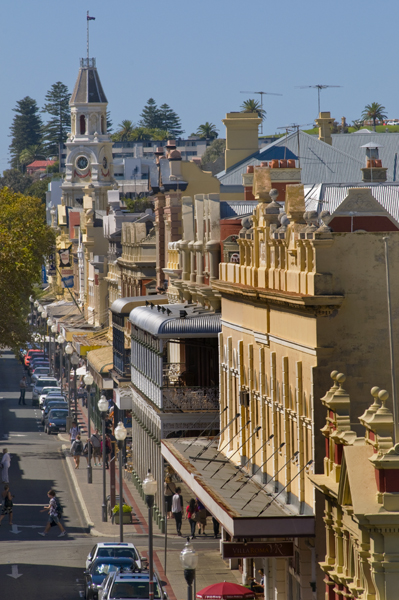 |
| High Street, Fremantle, WA |
 |
| High Street, Fremantle, WA |
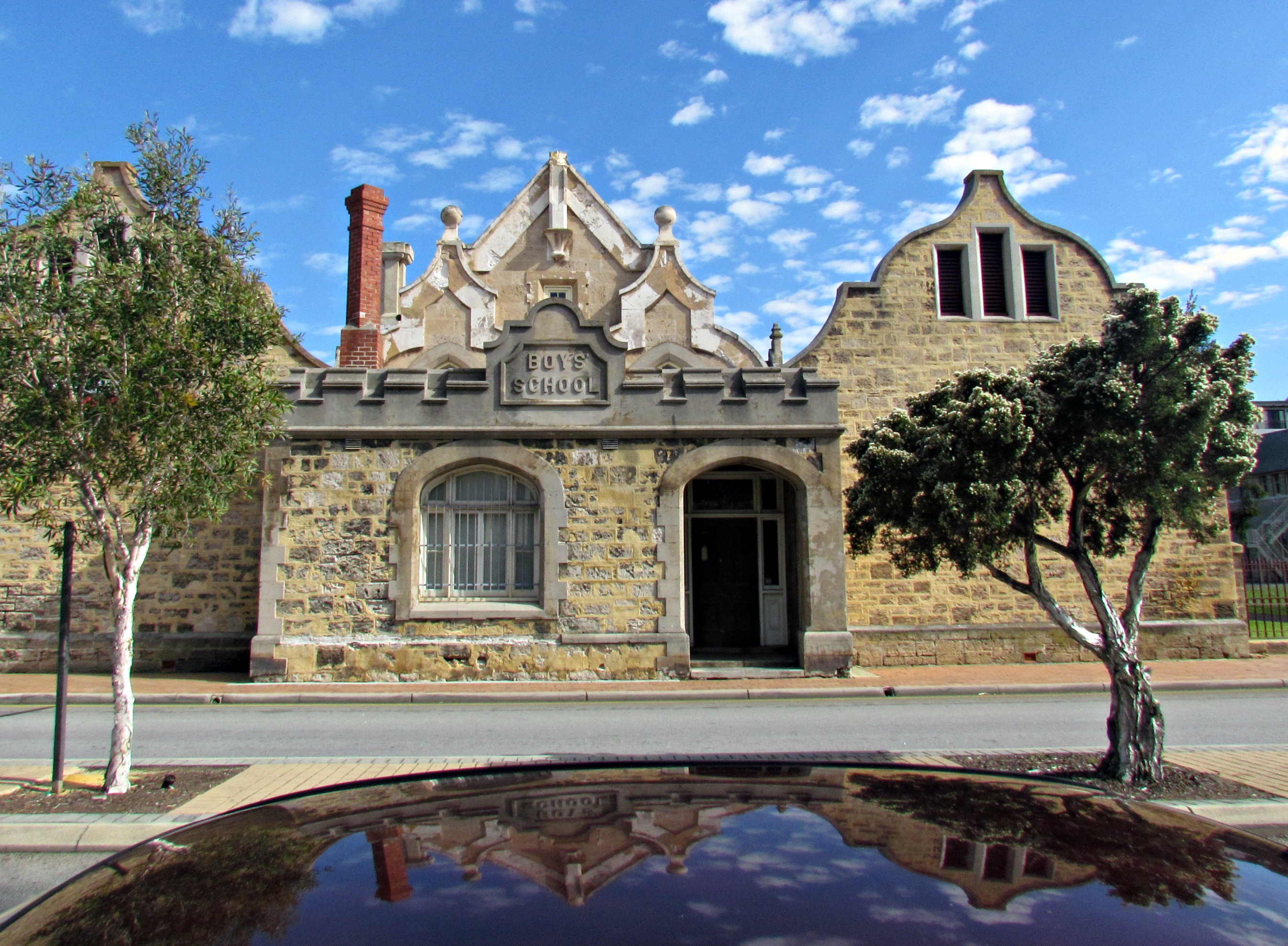 |
| Fremantle Boys School, WA, built between 1854 to 1911 |
 |
| Fremantle Prison Gatehouse, WA, circa 1855 |
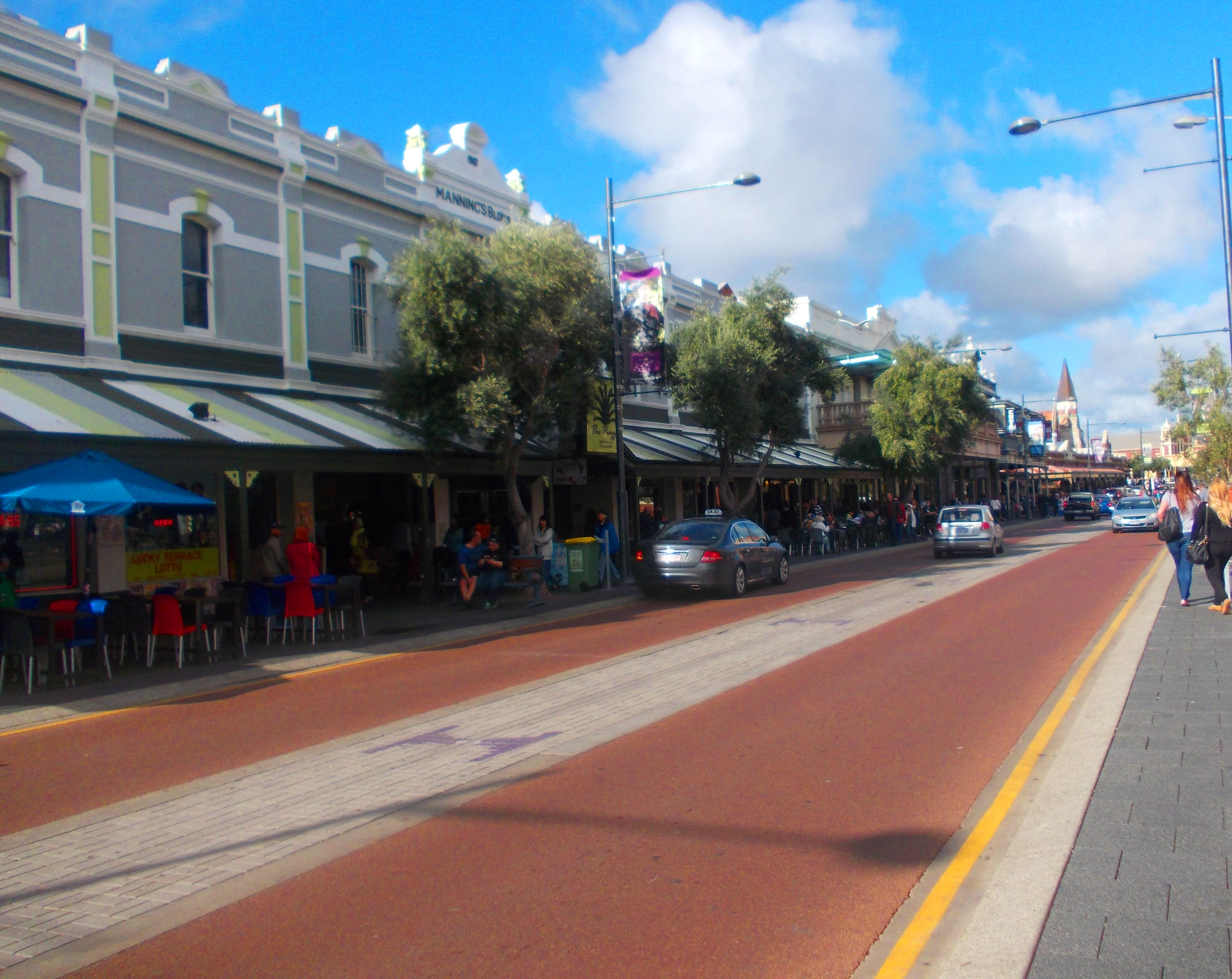 |
| South Terrace, Fremantle, WA |
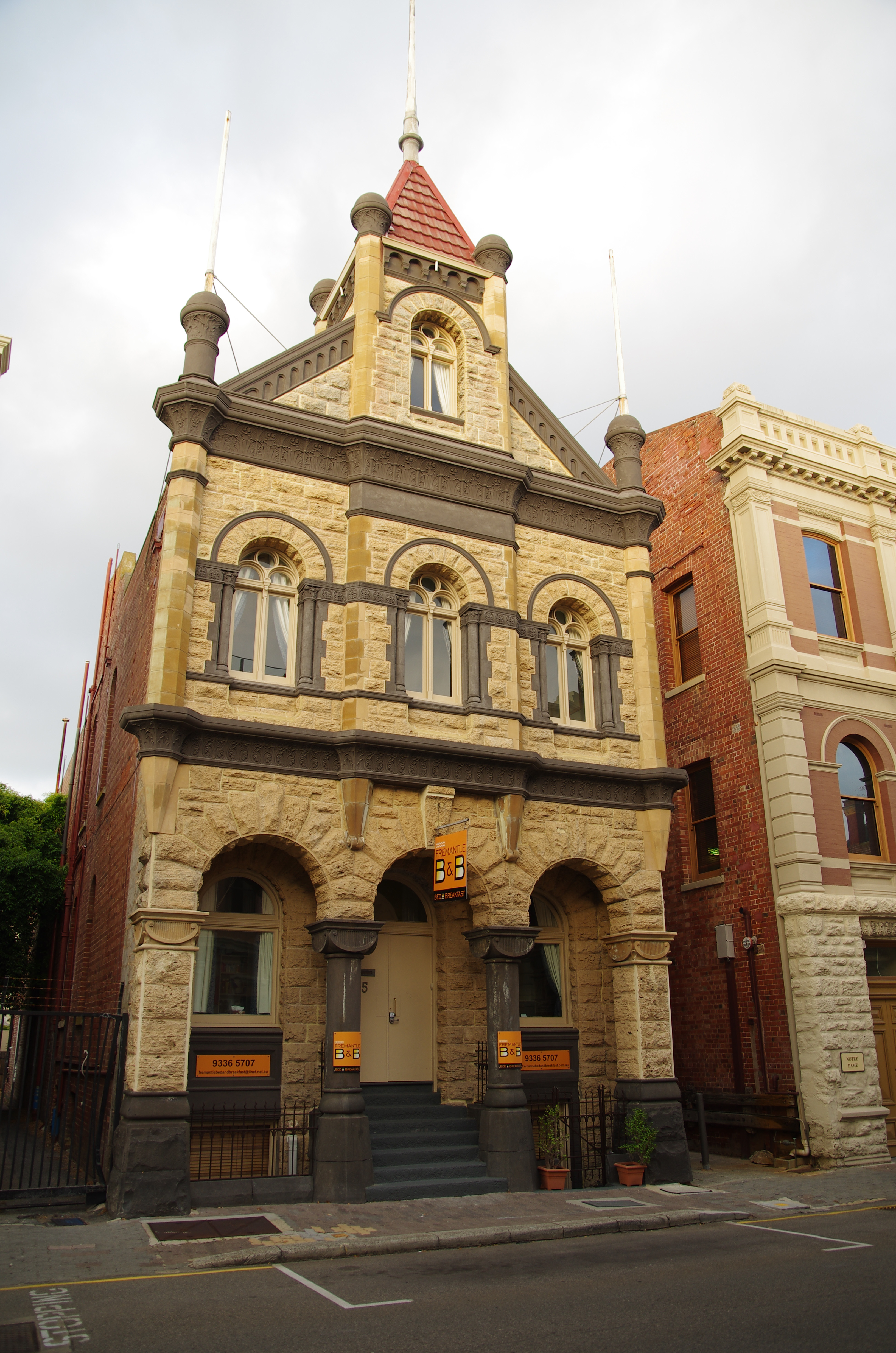 |
| Norddeutscher-Lloyd Building dates from the gold rush, Fremantle WA |
 |
| The former Union Bank of Australia Building, Built 1930, Fremantle WA |
 |
| The Fremantle Post Office opened in 1907, WA |
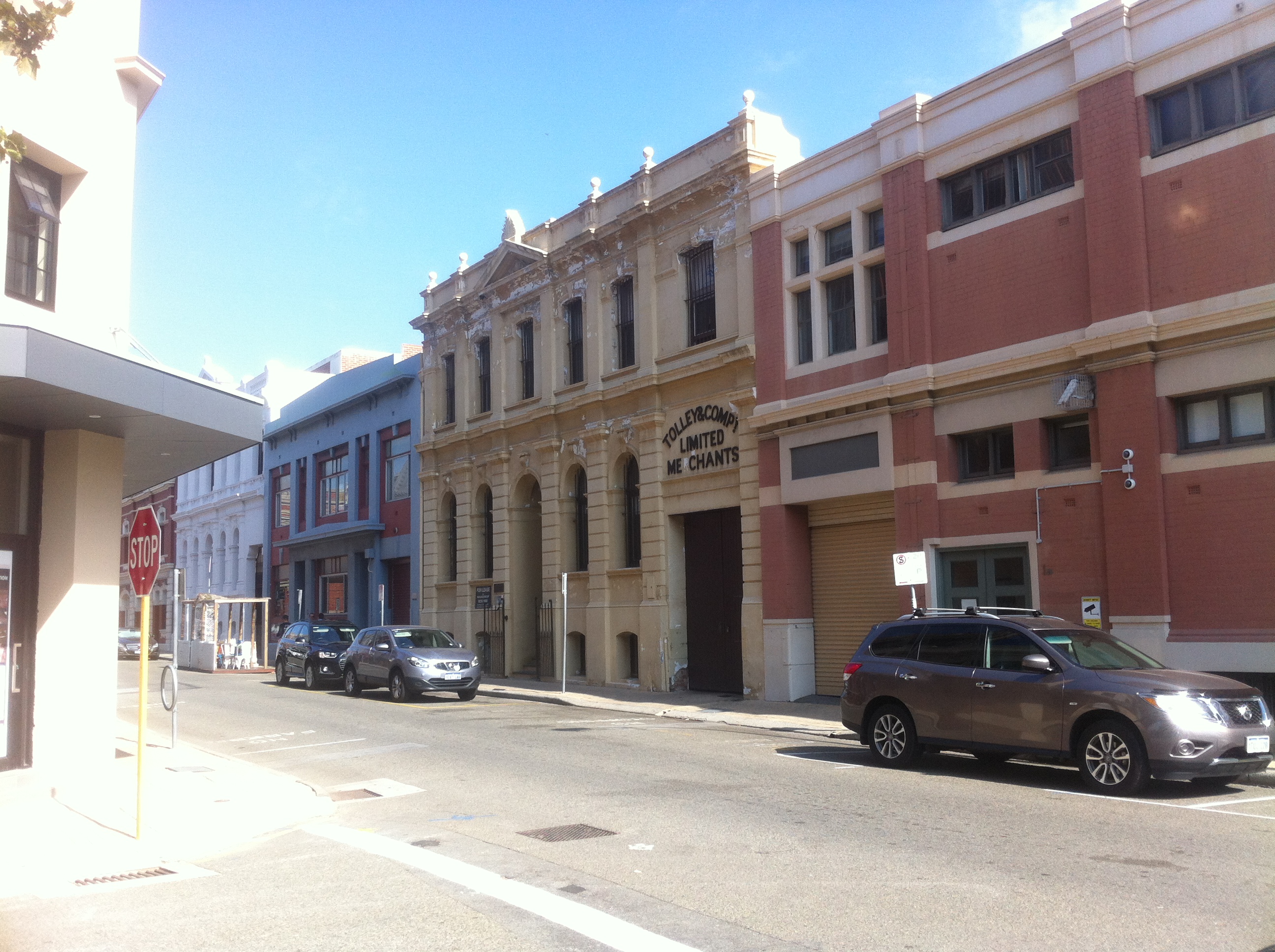 |
| Tolley & Company Warehouse, circa 1897, Fremantle WA |
 |
| Fremantle Fire Station WA, opened in 1909 |
 |
| Howard Smith Building. Construction of the building commenced in 1900, Fremantle WA |
 |
| Wilhemsen House, circa 1902, Fremantle WA |
 |
| The Princess Theatre, circa 1912, Fremantle WA |
 |
| Commercial Building, circa 1915, Fremantle WA |
 |
| 8 and 10 High Street, Fremantle, WA, Built in 1902 |
 |
| Robert Harper Flour Building, built 1890, Fremantle WA |
 |
| The first hotel was built on this site in the 1850s, with the Cleopatra Hotel being built in 1882, Fremantle WA |
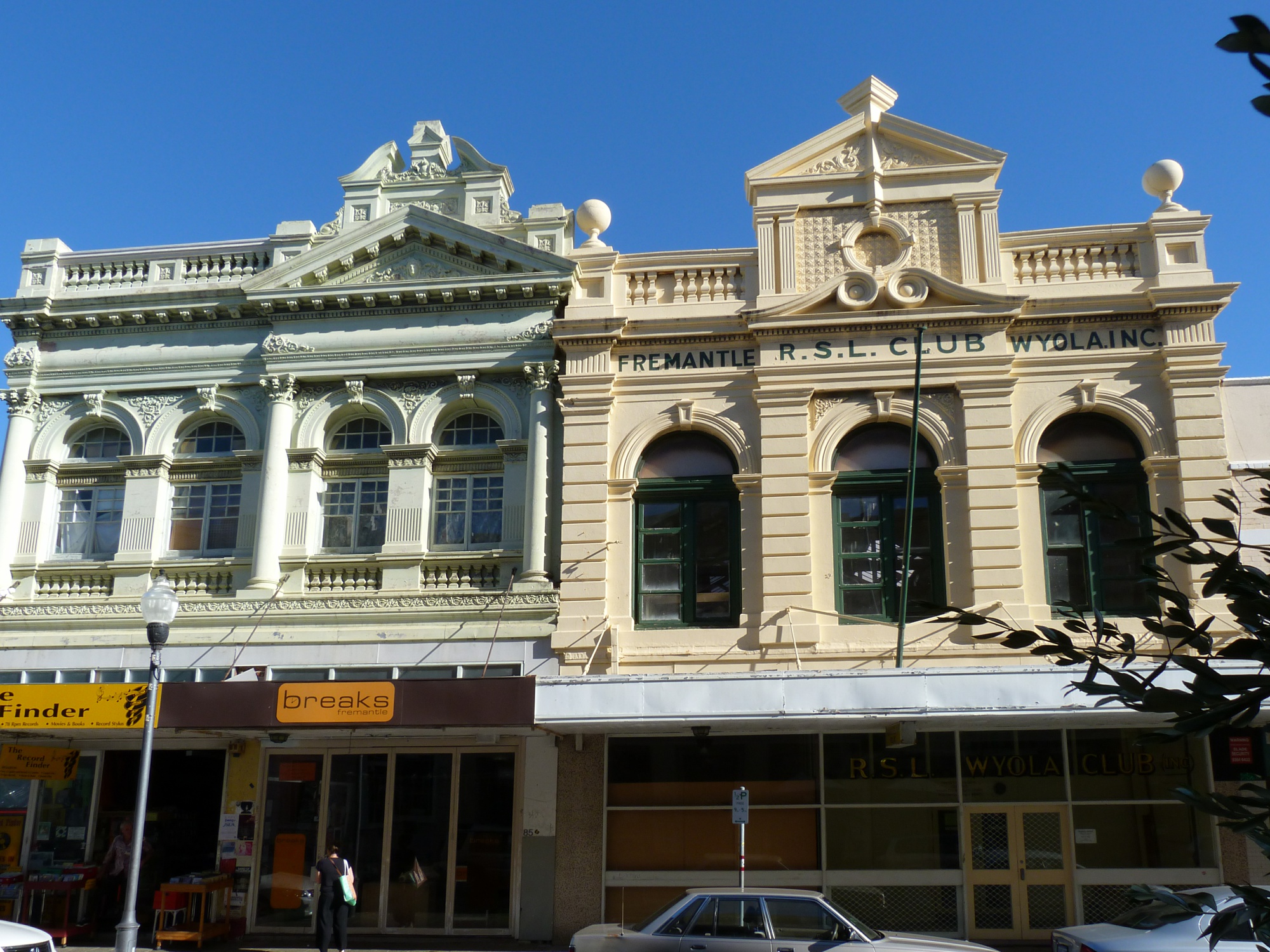 |
| RSL Club built in 1903, Fremantle WA |
 |
| Old Fremantle power station, WA, Attribution: Ché Lydia Xyang |
Things To Do and Places To Go
















_p103_THE_HARBOUR_OF_FREMANTLE%2C_WESTERN_AUSTRALIA.jpg)
_p109_FREMANTLE_JETTY.jpg)





























